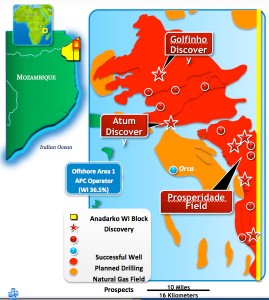Successful flow testing program paves way for East Africa field development
By Linda Hsieh, managing editor

A successful DST program on the Prosperidade field offshore Mozambique has allowed Anadarko Petroleum to reduce the number of appraisal wells that need to be drilled and provided confidence in well designs that are capable of up to 200 million cu ft/day, David Bump, Anadarko drilling and completions manager for Mozambique, said last week at the 2012 IADC Drilling Africa Conference in Lisbon, Portugal. During the DST program, the company was able to test at rates of more than 100 million cu ft/day for extended periods of five to eight days sustained flow at stable rates, Mr Bump said.
“That allowed us to prove up large areas of connected resource,” he continued, confirming the deliverability of this discovery area in Area 1 of the Rovuma Basin. Through a combination of multizone pressure monitoring using downhole gauges and acoustic telemetry, the company proved up to 3.5 km of connectivity in the northern part of Prosperidade; in the south, more than 7 km of connected resources was proven. Proving reservoir connectivity is a key step to achieving third-party reserves certification, which is necessary to advance the partnership’s LNG project, Mr Bump said.
Prosperidade, which includes the Windjammer, Barquentine, Lagosta and Camarão discoveries, as well as subsequent appraisal wells in the block, is estimated to hold 17-30 trillion cu ft of recoverable resources. With appraisal drilling complete, Mr Bump said, “our focus now is on commercialization.” He added that the company intends to go for full subsea development, with development drilling starting in the 2014-2015 time frame, depending on approval of the final development plan.
Another part of Anadarko’s Mozambique acreage in Area 1 is the Golfinho/Atum complex, which the company estimates holds 10-30 trillion cu ft of recoverable resources. “We’re repeating a similar (testing) campaign with three monitoring wells and two test wells in the Golfinho area to try and achieve the same thing – reduce that well count during appraisal, prove up a large area of connected resource,” Mr Bump said.
“Between these two areas we’re looking at over 30 to 60-plus Tcf just on Area 1,” he commented. “There’s also still a significant amount of resource potential in our license area. … We’ve only explored a very small portion of it.” An exploration well, Pérola Negra, is ongoing, and more are planned.
Because Mozambique is such a new E&P area, Mr Bump said, logistics has been a significant challenge: “There’s no infrastructure here to work off of, so we’ve had to bring it all ourselves.” Security has been another critical issue, he added.
Going into 2013, the company is working aggressively to shift from short-term operations to developing a long-term presence. Building capability within the country will be a priority considering the number of wells that is expected to be drilled there. The company also may look at moving from vessel-specific security arrangements to a broader regional security framework, Mr Bump said. This expanded security network will be important as the company looks “to have a substantial number of vessels out there for subsea installation activities; a lot of material and equipment is going to be moving into where the LNG facility is in northern Mozambique, along with ultimately the LNG carriers going in and out.”




